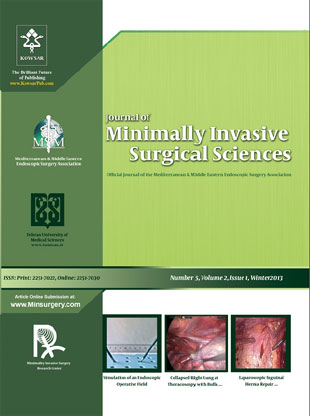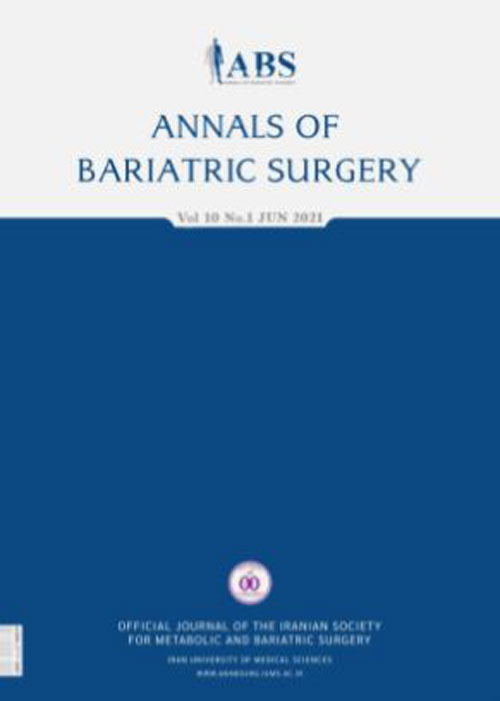فهرست مطالب

Annals of Bariatric Surgery
Volume:2 Issue: 1, Winter 2013
- تاریخ انتشار: 1391/11/20
- تعداد عناوین: 9
-
-
Page 3Bariatric surgery, as a whole, is the only proven modality to manage the severely obese. The laparoscopic sleeve gastrectomy (LSG) is the most recent tool in the armamentarium of bariatric surgery. Once used as the first-stage in a two-stage procedure for the super-obese patient, it is now used as a primary bariatric procedure. Involving the resection of the greater curvature of the stomach, it has been shown to achieve clinically significant excess weight loss and improvements in obesity-related co-morbidities. Its mechanism of action was originally classified as being a restrictive procedure, similar to laparoscopic gastric banding, but is now known to be far more complex. The pronounced effects of LSG on gut hormones such as ghrelin, PYY and incretins, allow this bariatric intervention to be adequately compared to the more historically classified malabsorptive procedures like the gastric bypass. In this review, we explore the metabolic effects and outcomes of LSG in producing significant weight loss and improving the factors associated with the metabolic syndrome..Keywords: Bariatric Surgery, Gastrectomy, Metabolic syndrome, Diabetes MellitusType 2
-
Page 8BackgroundInguinal hernia is the most prevalent surgical disease in clinical practice. Endoscopic inguinal hernia repair has been shown to be slightly superior to open approaches. Recent modifications in the minilaparoscopic technique may improve the totally extraperitoneal repair (TEP) results..ObjectivesWe have performed a prospective study to analyze the feasibility of laparoscopic inguinal hernia repair using mini instruments. Main measured outcomes included postoperative pain, return to work activities and aesthetics. Technical aspects, including operative time and intraoperative and postoperative complications were also analyzed..Patients andMethodsFrom October, 2009 to May, 2011 consecutive patients undergoing TEP inguinal hernia repair using mini-instruments were included in the study protocol. Exclusion criteria was the same as for standard laparoscopic hernia repair. In all cases, a standardized laparoscopic technique using mini instruments was performed. A study protocol was applied prospectively for data collection, including operative time, hospital stay, need for pain medication, return to work and, patient’s aesthetic evaluation of the scars. Results were expressed in Mean ± SD..ResultsSixty consecutive patients diagnosed with inguinal hernia underwent TEP inguinal hernia repair using mini instruments. Of these, 53 were men and seven were women. The mean age was 50 ± 32 years. In eight cases, the hernias were recurrent and ten were bilateral. A total of 70 hernias were treated. The average operative time was ± 35 min. The mean hospital stay was 18 ± 6 hours. Analgesia was necessary for more than 2 days in 8 patients (13.3 %). There was one conversion to open surgery. Sixteen of the male workers (37 %) had to take 1 week off work. In total, 58 (96 %) of the patients considered the aesthetic outcome to be excellent. Patients were followed for 30 days. No recurrences were noted in this period..ConclusionsTotally extraperitoneal endoscopic inguinal hernia repair using mini instruments is feasible, and applicable to routine surgical practice with good short-term clinical and aesthetic results. Further comparative studies with standard laparoscopic extraperitoneal and open hernia repair are needed to access its long term results..Keywords: Abdominal, Hernia, Instruments
-
Page 13BackgroundHysteroscopy is the gold standard method for diagnosis of intrauterine pathologies. Current study is a review of hysteroscopic findings performed over a period of 5 years in patients with abnormal uterine bleeding (AUB)..ObjectiveThe aim of this study was a review of hysteroscopic findings performed over a period of 5 years in patients with abnormal uterine bleeding (AUB)..Patients and Materials: This descriptive analytic study was conducted prospectively on patients in reproductive, premenopausal or postmenopausal ages referring to our hospital with complaint of AUB. All patients underwent hysteroscopy (either diagnostic or therapeutic) by the same surgeons. Analysis was performed on the base of the hysteroscopic findings..ResultsIn our population study (379 patients) major menstrual pattern was menometrorrhagia. The most common diagnoses at operative hysteroscopy were endometrial polyps (17.8%), hyperplastic endometrium (15.2%), and uterine submucosal myoma (9.7%).The most common findings in patients with menometrorrhagia were myoma, and polyp where, the most common finding in patients with menorrhagia, and metrorrhagia was polyp. Our major complications were uterine perforation in 9, thermal injury in 3, and air emboli in one case..ConclusionsIn current study the most common pathology was found to be endometrial polyp. Myoma was the most common finding in patients with menometrorrhagic bleeding. Our major complications were uterine perforation, thermal injury, and air emboli..Keywords: Uterine Hemorrhage, Endometrial hyperplasia, Hysteroscopy, Myoma
-
Page 18BackgroundPostoperative nausea and vomiting (PONV) is an unpleasant, distressing and frequent adverse effect after general anesthesia and surgery which has a high incidence in patients undergoing laparoscopic cholecystectomy. While none of the currently available antiemetic drugs are fully effective in all patients, it has been reported that dexamethasone is effective against emesis in patients undergoing general anesthesia..ObjectivesThis study evaluates the prophylactic anti-emetic effect of dexamethasone in comparison with metoclopramide and placebo for the prevention of post-operative nausea and vomiting in patients undergoing elective laparoscopic cholecystectomy..Patients andMethodsIn Mostafa Khomeini hospital, a teaching hospital of Shahed University, Tehran, Iran, a randomized, double-blind and placebo-controlled study on 161 patients undergoing general anesthesia for elective laparoscopic cholecystectomy was run. One hundred sixty one patients (124 females and 37 males) requiring general anesthesia for laparoscopic cholecystectomy were studied. The dexamethasone group (n = 53) received dexamethasone 8mg IV, the metoclopramide group (n = 55) received metoclopramide 10mg IV and the placebo group (n = 53) received 2ml saline IV at the induction of anesthesia..ResultsIn the current study, 26.4 %, 32.7 % and 52.8 % of patients reported vomiting in the dexamethasone, metoclopramide and placebo group (P < 0.001), respectively. The total incidence of nausea and vomiting also reduced to 30.2 % with dexamethasone in comparison with 49.1 % in metoclopramide group and 58.5 % in placebo group. (P < 0.001).ConclusionsDexamethasone 8mg is a better anti-emetic agent than metoclopramide for the prevention of post-operative nausea and vomiting after laparoscopic cholecystectomy..Keywords: Vomiting, Dexamethasone, Cholecystectomy, Laparoscopic
-
Page 23BackgroundTraditional haemostatic techniques in total thyroidectomy may cause some damages to surrounding tissues. It is believed that these damages can be reduced using ultrasonic dissector devices like Harmonic Scalpel (HS)..ObjectiveIn this study, we investigated the efficacy of ultrasonic dissectors (HS) versus conventional techniques (Clamp and Tie)..Patients andMethodsA single blinded randomized clinical trial was performed at a referral educational center. Sixty eight eligible participants were enrolled and assigned to conventional group (operated with Clamp and Tie technique) and HS group (operated with Harmonic Scalpel). The following items were recorded in both groups: haemostatic technique, operative blood loss, duration of surgery, length of hospital stay, pathology, thyroid weight, postoperative recurrent laryngeal nerve injury, change in calcemia, pain, drainage volume and hematoma formation..ResultsThe results demonstrated that application of HS in thyroidectomy significantly reduces operating time (P < 0.0001) and Intra operative bleeding (P < 0.0001). Postoperative drainage (P < 0.0001), pain (P < 0.0001), hypocalcemia (P < 0.0001), and length of hospitalization (P < 0.0001) were significantly lower in HS group. Voice score was significantly lower in HS group (P < 0.0001)..ConclusionsHS in total thyroidectomy, reduces operating time, blood loss, postoperative pain, drainage volume, voice changes, and postoperative hypocalcemia, compared to conventional techniques..Keywords: Hemorrhage, Pain, Postoperative, Thyroidectomy, Ultrasonics
-
Page 28IntroductionAmyand’s hernia – the presence of appendix within an inguinal hernia sac poses a diagnostic and therapeutic challenge in the acute setting..Case PresentationWe report the case of a female patient on long-term corticosteroid therapy that was found at laparoscopy to have an inflamed appendix incarcerated within a right inguinal hernia. A 62-year-old Caucasian female presented with a short history of sudden-onset pain in the right groin. Her past medical history included polymyalgia rheumatic for which she had been treated over the past 4 years with oral prednisolone. The studied case was successfully treated through laparoscopic appendectomy and laparoscopic suturing of the deep inguinal ring..DiscussionThis totally laparoscopic approach may be of use in cases where definitive treatment with mesh cannot be undertaken and the avoidance of large wounds is desirable..Keywords: Hernia, Appendicitis, Laparoscopy
-
Page 31BackgroundSpontaneous pneumothorax hardly occurs in healthy children. Diagnosing its etiology can be difficult. Chest X ray and Computerized Tomographic scan (CT) are useful investigations but have limitations. CT scan in combination with video assisted thoracoscopic surgery (VATS) improves diagnostic accuracy and facilitates appropriate management of non-resolving spontaneous pneumothorax. Showcased are images demonstrating how effectively CT complements video assisted thoracoscopic surgery (VATS) in managing a recalcitrant case of spontaneous pneumothorax caused by a solitary bulla..ObjectivesA 15 year old boy presented to the referring hospital with a right sided spontaneous pneumothorax which occurred whilst playing football.Case report: A 15 year old boy presented to the referring hospital with a right sided spontaneous pneumothorax which occurred whilst playing football. His symptoms were shortness of breath and right pleurisy chest pain. His oxygen saturations were more than 95% on air. A needle aspiration was performed yielding 2300mls of air, however the pneumothorax persisted..ConclusionsIn cases of pontaneous pneumothorax, Chest X ray and Computerised Tomographic scan have limitations. CT scan in combination with video assisted thoracoscopic surgery improves diagnostic accuracy and facilitates appropriate management of non-resolving spontaneous pneumothorax..Keywords: Pneumothorax, Spontaneous, Blebs, Vat Protein
-
Page 35


